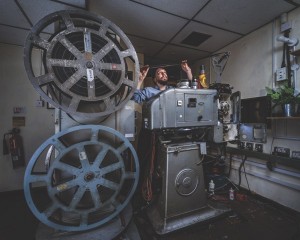The Projection Project
Dr Richard Wallace, University of Warwick, casts the lens on an AHRC-funded project examining the history of cinema projection and the switch to digital.
About the Author: Dr Richard Wallace is a Research Fellow in the Department of Film and Television Studies at the University of Warwick. He gained his BA (Hons) in Film and Literature at the University of Warwick, where he also completed his MA (For Research) in Film and Televisions Studies and PhD in Film and Television Studies. His research interests include aspects of British television history, film and television documentary, and screen comedy. Between 2013 and 2014 he was the project officer on the ‘Voices of the University: Memories of Warwick, 1965 – 2015’ oral history project running in the Institute of Advances Study at Warwick. Richard is also a member of the Midlands Television Research Group and convened the group betwenn 2012 and 2014.
From Analogue to Digital: The Projection Project
Over the last decade, UK cinemas have undergone a digital revolution. In the hidden spaces that lie at the back of the auditorium the large, mechanical, and familiar film projectors have almost completely disappeared from behind the small glass portholes, replaced by digital counterparts (sealed black boxes). To give some idea of what this means in practice, the 35mm projector that serves Screen 1 of The Electric Cinema, Birmingham is the city’s only functioning in situ analogue film projector. We Can Show Film, a UK-based organisation which provides an online resource for venues and people who still work with film, estimates that there are only 50 screens in UK cinemas that are still capable of showing 35mm film. To put this in perspective, the Odeon chain alone runs 868 screens in the UK.
The removal of film projectors from cinemas has also meant that those employees whose job it was to work with film have become surplus to requirements in most cinemas. The projectionist is now an endangered species. ‘The Projection Project’, running in the Department of Film and Television Studies at the University of Warwick, is dedicated to examining the work of the projectionist within this context of digitisation. Funded by the Arts and Humanities Research Council (AHRC), the project is reaching the end of its second year (it will run until January 2018).

Projectionist Sam Bishop, The Electric, Birmingham. Part of The Projectionists exhibition. (Photo by Richard Nicholson)
The project is concerned with the present, the history and the future of projection inside and outside the cinema. The history of cinema projection in the UK is being addressed by Prof Charlotte Brunsdon, Dr Jon Burrows and Dr Richard Wallace. Interviews with current and former career projectionists provide a first-person view of the work done by projectionists and how this has changed over time in response to industrial, technological and social changes. Audio and paper archives will give a sense of how cinema projection has changed and developed across the whole history of cinema, particularly those years that are now outside, or at the very edge of, living memory. As public perceptions of the otherwise hidden projectionist have largely been shaped by their representation in fiction films, there is a PhD student on the project – Claire Jesson – examining the history of screen depictions of projection. Contemporary projection practice (both film and digital) outside of the cinema, including projection mapping, guerrilla projection and artistic ‘bring your own beamer’ events are being addressed by Dr Michael Pigott.
At the heart of the project, then, is the core relationship between history and contemporary digital transformations. This is obviously a key driving force behind the research and a major focus of it. However it also influences our own working and research processes. Ironically, digital technologies have become indispensable tools in our ability to research analogue work and technology, and the impact of digital on them. This can be seen at a very basic practical level through its influence on the workflow of the research. The digital audio recorder that I use to interview the projectionists allows me to record hours of material uninterrupted on a memory card, which does not have to be frequently removed, replaced or turned over as used to be the case with an analogue cassette. I can back up the files quickly and easily, share them with colleagues, or send them to a remote location for transcription in a matter of minutes without any risk of data loss. The interviews can be coded and analysed using specialist software. In the archive my iPad allows me to photograph material (usually) cheaply and easily and I can enhance, enlarge and clarify material, such as scrawled notes hand-written in the late 1930s, with the help of software packages.
There is however a more conceptual way in which digital tools operate for us on The Projection Project. By using digital tools to investigate digital transformations we become part of the processes that we are documenting, and indeed our own work and working methods become part of the research.
 Learning on Screen
Learning on Screen